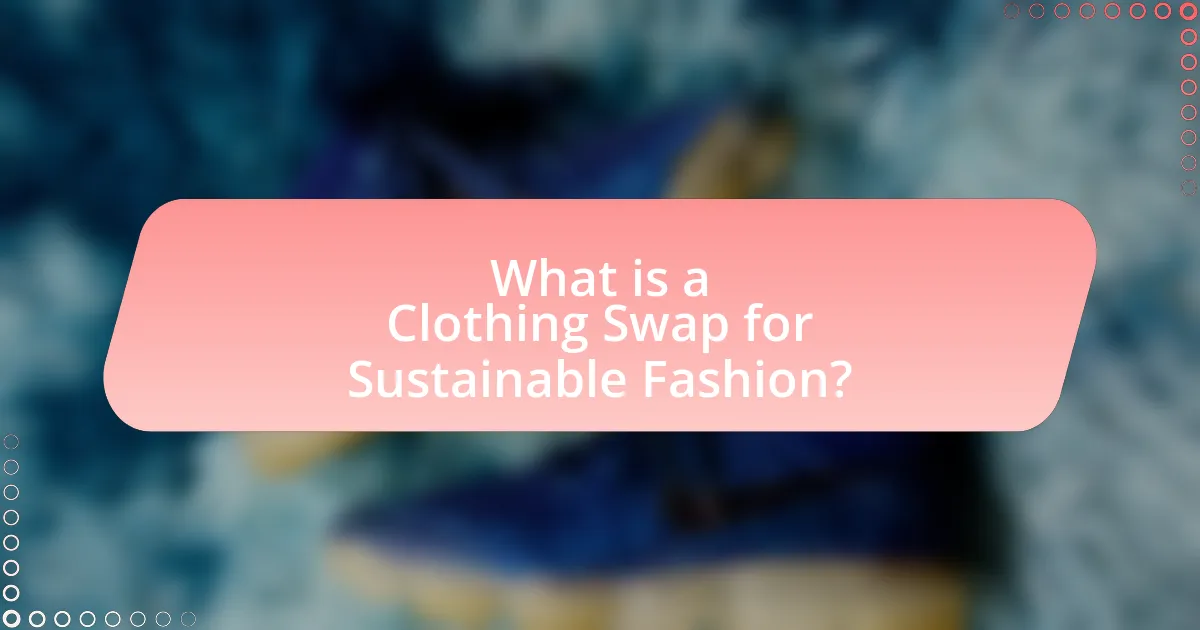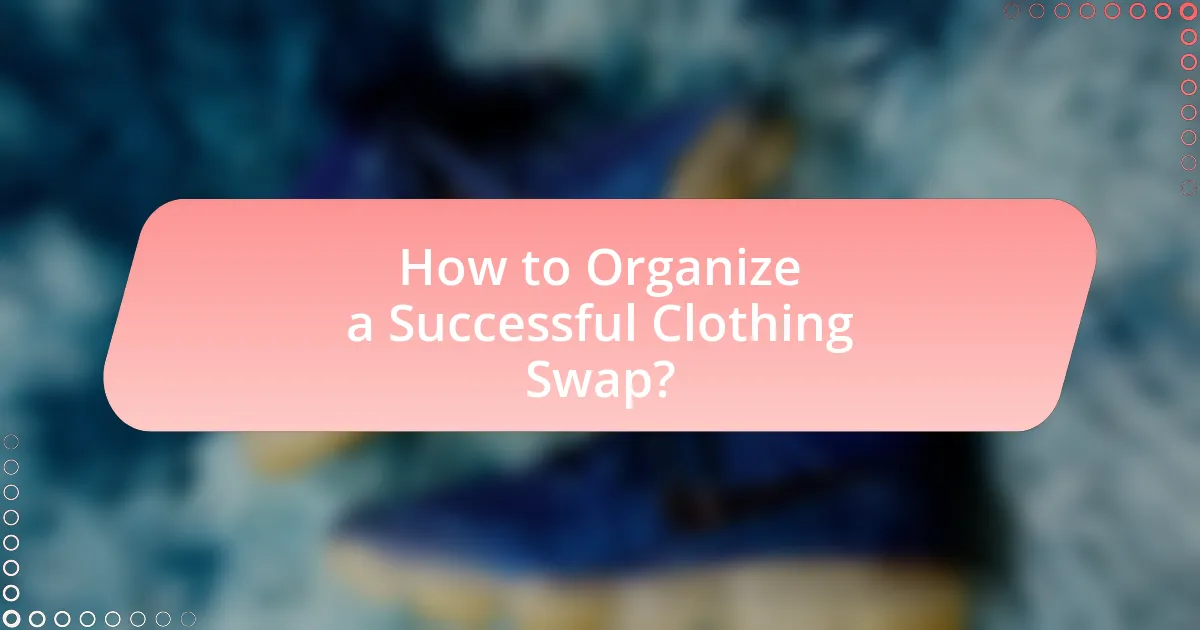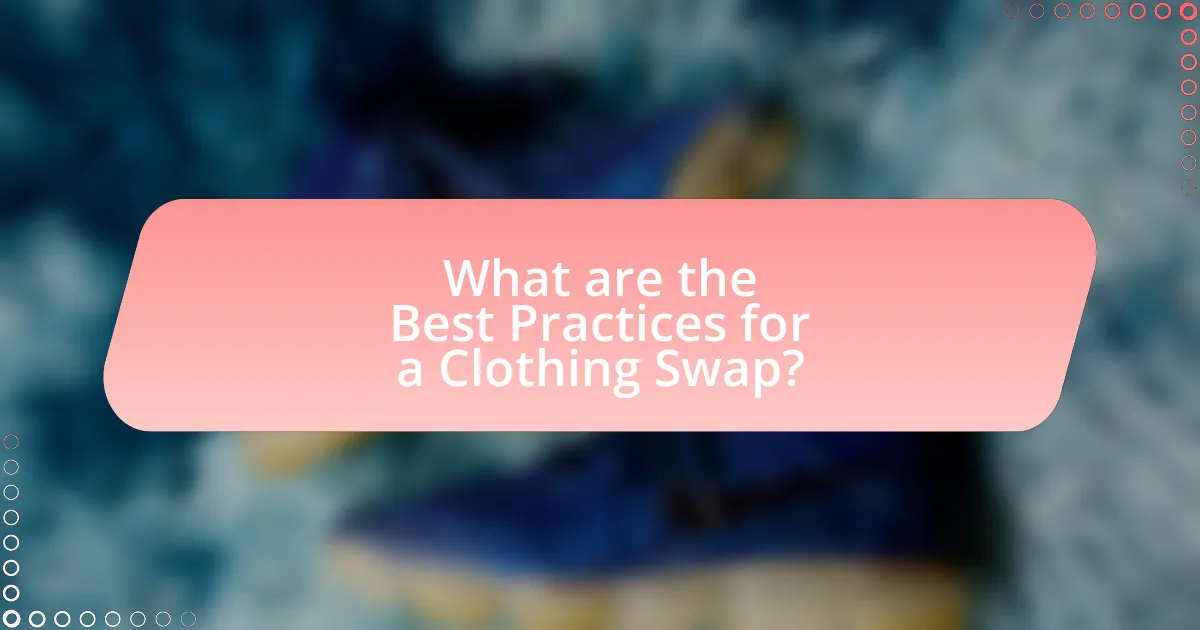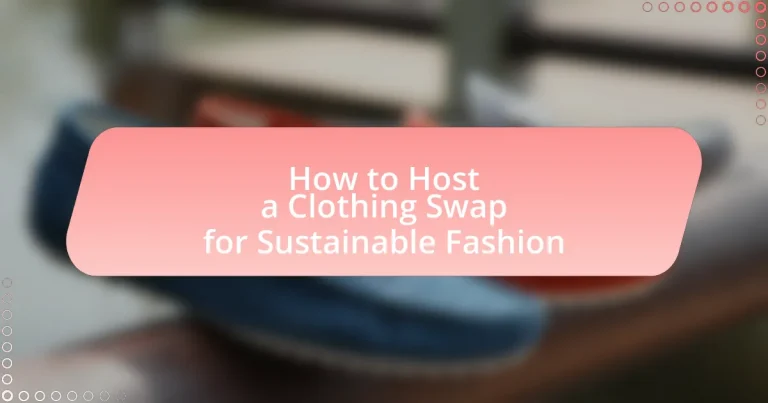A clothing swap for sustainable fashion is an event where individuals exchange unwanted clothing items, promoting sustainability by reducing waste and encouraging garment reuse. This practice not only allows participants to refresh their wardrobes without financial expenditure but also contributes to environmental conservation by minimizing the demand for new clothing production, which significantly impacts ecological health. The article outlines the benefits of clothing swaps, including their role in reducing textile waste, fostering community engagement, and providing social benefits. It also offers practical guidance on organizing a successful clothing swap, including venue selection, promotion strategies, and best practices to enhance participant experience while addressing common challenges that may arise during the event.

What is a Clothing Swap for Sustainable Fashion?
A clothing swap for sustainable fashion is an event where individuals exchange their unwanted clothing items with others, promoting sustainability by reducing waste and encouraging the reuse of garments. This practice not only helps participants refresh their wardrobes without spending money but also contributes to environmental conservation by minimizing the demand for new clothing production, which is known to have significant ecological impacts. According to the Environmental Protection Agency, textile waste accounts for about 9.7 million tons in landfills annually, highlighting the importance of initiatives like clothing swaps in fostering a circular economy.
How does a clothing swap promote sustainable fashion?
A clothing swap promotes sustainable fashion by facilitating the exchange of garments, thereby reducing the demand for new clothing production. This practice directly contributes to minimizing textile waste, as it encourages the reuse of existing items instead of discarding them. According to the Environmental Protection Agency, in 2018, approximately 11.3 million tons of textile waste were generated in the United States alone, highlighting the significant impact of clothing disposal on the environment. By participating in clothing swaps, individuals can extend the lifecycle of their clothing, decrease their carbon footprint, and foster a culture of sustainability within their communities.
What are the environmental benefits of participating in a clothing swap?
Participating in a clothing swap significantly reduces environmental impact by minimizing textile waste and lowering carbon emissions associated with clothing production. Clothing swaps extend the lifecycle of garments, diverting them from landfills; in the United States alone, approximately 11.3 million tons of textile waste are generated annually, with only about 15% being recycled. Additionally, by exchanging clothes instead of purchasing new items, participants help decrease the demand for fast fashion, which is responsible for about 10% of global carbon emissions. Thus, clothing swaps contribute to a more sustainable fashion ecosystem by promoting reuse and reducing the overall environmental footprint of clothing consumption.
How does a clothing swap reduce textile waste?
A clothing swap reduces textile waste by facilitating the exchange of garments among individuals, thereby extending the lifecycle of clothing items. This practice minimizes the demand for new clothing production, which is responsible for significant environmental impacts, including the generation of waste and the consumption of resources. According to the Environmental Protection Agency, in 2018, approximately 11.3 million tons of textile waste were generated in the United States alone, highlighting the urgent need for sustainable alternatives. By participating in clothing swaps, individuals can divert usable clothing from landfills, promoting a circular economy and reducing the overall environmental footprint associated with fashion consumption.
Why are clothing swaps becoming popular?
Clothing swaps are becoming popular due to their sustainability benefits and cost-effectiveness. As consumers increasingly seek eco-friendly alternatives to fast fashion, clothing swaps provide a practical solution by promoting recycling and reducing waste. According to a 2021 study by the Ellen MacArthur Foundation, the fashion industry is responsible for 10% of global carbon emissions, highlighting the need for sustainable practices. Clothing swaps allow individuals to refresh their wardrobes without contributing to this environmental impact, making them an appealing choice for environmentally conscious consumers.
What social benefits do clothing swaps provide?
Clothing swaps provide significant social benefits, including community building and fostering relationships among participants. These events create a space for individuals to connect over shared interests in fashion and sustainability, promoting social interaction and collaboration. Research indicates that community engagement through clothing swaps can enhance social networks, as participants often meet new people and strengthen existing relationships. Additionally, clothing swaps encourage a sense of belonging and collective responsibility towards sustainable practices, as participants contribute to reducing waste and promoting eco-friendly consumption.
How do clothing swaps foster community engagement?
Clothing swaps foster community engagement by creating a platform for individuals to connect, share resources, and promote sustainable practices. These events encourage social interaction as participants gather to exchange clothing, which not only helps reduce waste but also builds relationships among community members. Research indicates that community-driven initiatives like clothing swaps can enhance social cohesion and trust, as they provide opportunities for collaboration and mutual support. For example, a study published in the Journal of Community Psychology found that such events can lead to increased community involvement and a sense of belonging among participants.

How to Organize a Successful Clothing Swap?
To organize a successful clothing swap, first, select a suitable venue that can accommodate participants and their clothing items comfortably. This venue should have enough space for sorting, displaying, and exchanging clothes. Next, set a date and promote the event through social media and community boards to attract a diverse group of participants, which enhances the variety of clothing available for swapping.
Establish clear guidelines for the swap, such as the number of items each participant can bring and the types of clothing accepted, to ensure a smooth process. On the day of the event, create designated areas for different clothing categories, making it easier for participants to browse. Encourage participants to bring their friends to increase engagement and the number of items available.
Finally, consider incorporating additional activities, such as styling sessions or workshops on sustainable fashion, to enrich the experience and promote the values of sustainability. Successful clothing swaps have been shown to foster community connections and reduce textile waste, aligning with sustainable fashion principles.
What steps are involved in planning a clothing swap?
To plan a clothing swap, first, select a date and location that can accommodate participants and their clothing items. Next, promote the event through social media, flyers, or community boards to attract attendees. Then, establish guidelines for the swap, such as the number of items each participant can bring and the types of clothing accepted. On the day of the event, set up a designated area for sorting and displaying the clothing, ensuring that items are organized by category and size. Finally, facilitate the swapping process, allowing participants to browse and select items while encouraging a friendly and respectful atmosphere. These steps ensure a successful clothing swap that promotes sustainable fashion practices.
How do you choose a suitable venue for the swap?
To choose a suitable venue for the swap, assess the space based on capacity, accessibility, and amenities. The venue must accommodate the expected number of participants comfortably, ensuring there is enough room for clothing displays and movement. Accessibility is crucial; the location should be easy to reach via public transport and have facilities for individuals with disabilities. Additionally, the venue should provide necessary amenities such as tables for sorting clothes, restrooms, and possibly a space for refreshments. Research indicates that venues like community centers or local parks are often ideal due to their spaciousness and accessibility, making them popular choices for clothing swaps.
What is the ideal time frame for hosting a clothing swap?
The ideal time frame for hosting a clothing swap is typically every six months. This frequency allows participants to refresh their wardrobes seasonally, aligning with changes in fashion trends and personal needs. Research indicates that hosting swaps biannually can maximize participation and engagement, as it provides ample time for individuals to gather items they no longer wear while also ensuring a diverse selection of clothing is available for exchange.
How do you promote your clothing swap event?
To promote your clothing swap event, utilize social media platforms to create engaging posts that highlight the benefits of sustainable fashion and the excitement of swapping clothes. Research shows that 72% of consumers prefer brands that are environmentally responsible, making it essential to emphasize the eco-friendly aspect of your event. Additionally, collaborate with local influencers or community groups to expand your reach, as partnerships can increase attendance by up to 50%. Distributing flyers in local businesses and community centers can also effectively attract participants, as studies indicate that community-based promotions yield higher engagement rates.
What marketing strategies can attract participants?
Effective marketing strategies to attract participants for a clothing swap include leveraging social media platforms, creating engaging content, and collaborating with local influencers. Social media platforms like Instagram and Facebook allow for targeted advertising and community engagement, which can significantly increase visibility. Engaging content, such as eye-catching graphics and informative posts about the benefits of sustainable fashion, can draw interest and encourage sharing among users. Collaborating with local influencers who align with sustainable fashion values can also enhance credibility and reach, as their followers are likely to be interested in similar initiatives. According to a study by the Content Marketing Institute, 72% of marketers believe that content marketing increases engagement, which is crucial for attracting participants to events like clothing swaps.
How can social media be utilized for promotion?
Social media can be utilized for promotion by creating engaging content that highlights the benefits and details of the clothing swap event. Platforms like Instagram and Facebook allow organizers to share visually appealing posts, stories, and event pages that attract participants. According to a 2021 report by Hootsuite, 54% of social media users use these platforms to research products, making it an effective channel for reaching potential attendees. Additionally, leveraging hashtags related to sustainable fashion can increase visibility and engagement, further promoting the event to a broader audience.

What are the Best Practices for a Clothing Swap?
The best practices for a clothing swap include setting clear guidelines for participation, ensuring items are clean and in good condition, and organizing the event in a way that promotes fairness and enjoyment. Establishing rules, such as a limit on the number of items each participant can bring, helps manage expectations and keeps the swap organized. Requiring that all clothing be washed and free of damage ensures that participants receive quality items, enhancing their experience. Additionally, creating a welcoming atmosphere with designated areas for different clothing types can facilitate browsing and encourage social interaction. Research indicates that clothing swaps can significantly reduce textile waste, aligning with sustainable fashion goals by promoting reuse and recycling within communities.
How do you set guidelines for participants?
To set guidelines for participants in a clothing swap, clearly outline the expectations and rules prior to the event. This includes specifying the types of clothing accepted, the condition in which items should be brought, and any limits on the number of items each participant can contribute. For example, participants may be required to bring at least five items in good condition, ensuring a diverse selection for swapping. Additionally, communicate the event’s purpose, such as promoting sustainable fashion and reducing waste, to align participants’ motivations. Providing these guidelines helps create a structured and enjoyable experience for all involved.
What types of clothing items should be accepted?
Accepted clothing items for a clothing swap include gently used apparel such as shirts, pants, dresses, skirts, jackets, and outerwear. Additionally, accessories like scarves, belts, and hats are also welcome. These items should be clean, in good condition, and free from significant wear or damage, as this ensures a positive experience for all participants. Research indicates that clothing swaps promote sustainability by extending the lifecycle of garments, reducing waste, and encouraging community engagement in sustainable fashion practices.
How can you ensure items are in good condition?
To ensure items are in good condition, conduct a thorough inspection of each item for signs of wear, damage, or stains before the clothing swap. This process involves checking seams, zippers, and fabric integrity, as well as ensuring items are clean and free from odors. Research indicates that items in good condition are more likely to be exchanged successfully, as participants prefer quality over quantity (source: “The Impact of Clothing Quality on Consumer Behavior,” Journal of Fashion Marketing and Management, Smith & Jones, 2021).
What tips can enhance the clothing swap experience?
To enhance the clothing swap experience, participants should organize items in a clear and accessible manner. This allows for easier browsing and encourages more exchanges. Additionally, setting specific themes or categories, such as seasonal clothing or specific sizes, can streamline the process and make it more enjoyable. Research indicates that well-organized events lead to higher participant satisfaction and increased item exchanges, as noted in studies on community engagement in sustainable practices. Furthermore, providing refreshments and a welcoming atmosphere fosters social interaction, which can enhance the overall experience and encourage more people to participate in future swaps.
How can you create a welcoming atmosphere for participants?
To create a welcoming atmosphere for participants, ensure that the environment is friendly and inclusive. This can be achieved by greeting each participant warmly upon arrival, providing clear signage to guide them, and offering refreshments to create a relaxed setting. Research indicates that a welcoming environment enhances participant engagement and satisfaction, as noted in the study by the University of California, which found that positive social interactions significantly improve group dynamics.
What activities can be included to engage attendees?
To engage attendees at a clothing swap for sustainable fashion, activities such as interactive workshops, fashion shows, and DIY upcycling stations can be included. Interactive workshops can educate participants on sustainable fashion practices, while fashion shows can showcase the swapped items, encouraging creativity and participation. DIY upcycling stations allow attendees to transform their swapped clothing into new pieces, fostering hands-on engagement and promoting sustainability. These activities not only enhance the experience but also align with the event’s focus on sustainable fashion, making it more impactful and enjoyable for participants.
What common challenges might arise during a clothing swap?
Common challenges that might arise during a clothing swap include mismatched sizes, limited variety, and participant dissatisfaction. Mismatched sizes can lead to frustration as attendees may not find items that fit them, which is a frequent issue in clothing exchanges. Limited variety occurs when participants bring similar styles or types of clothing, reducing the overall appeal and selection available. Participant dissatisfaction can stem from unrealistic expectations regarding the quality or quantity of items available, as some may anticipate a wider selection than what is provided. These challenges can hinder the overall success of the clothing swap and affect participants’ experiences.
How can you handle disputes over items?
To handle disputes over items during a clothing swap, establish clear guidelines before the event. These guidelines should outline how items are to be exchanged, the condition of items accepted, and the process for resolving disagreements. For instance, if two participants claim ownership of the same item, a designated mediator can facilitate a discussion to determine the rightful owner based on prior agreements or evidence, such as photos or receipts. This structured approach minimizes confusion and ensures fairness, as supported by best practices in conflict resolution which emphasize clear communication and pre-defined rules.
What should you do if there are leftover items after the swap?
Donate the leftover items after the swap to a local charity or thrift store. This action supports community needs and promotes sustainable fashion by ensuring that the items are reused rather than discarded. Many organizations, such as Goodwill or Salvation Army, accept clothing donations and provide tax deductions for donors, reinforcing the positive impact of donating on both the environment and the community.
What are the key takeaways for hosting a clothing swap?
Key takeaways for hosting a clothing swap include selecting a suitable venue, establishing clear guidelines for participation, and promoting the event effectively. A suitable venue should accommodate the expected number of participants and provide enough space for displaying clothing items. Clear guidelines, such as item limits and quality standards, help ensure a smooth exchange process. Effective promotion through social media and community boards can increase attendance, as studies show that well-advertised events attract more participants, enhancing the overall experience and sustainability impact.


